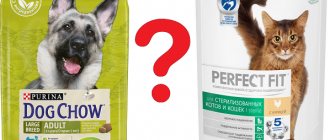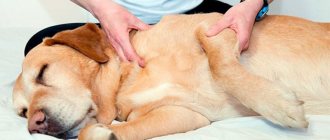Dog bones are an eternal topic of debate. Some consider them a universal delicacy, while others consider them a forbidden product that has no place in a pet’s bowl. Both are ready to defend their point of view until they are hoarse. This article is intended to dispel the myths created by those who claim that a dog is primarily a predator, and to answer the question: should you feed your pet moles or not?
photo from website: LittleThings.com
What should we do if we think our pet doesn’t have enough solid food in his diet? Most owners rely on bones - beef, chicken, pork and others. After all, this is a truly universal way to keep the dog occupied for a long time, watching how it growls with its prey, and to pamper it with what is left directly from the carcass. However, when we give our pets such a dubious “toy”, we forget about the dangers that this product is fraught with – be it in its natural form or boiled.
What bones can be given to dogs and is it possible: let’s sort it all out in order
The owner wants to feed and please, but the animal ends up with serious health problems. What is this? This is a scenario that you bring to life by presenting your pets with something that you yourself are not able to eat. Many dog owners forget that unprocessed fragments that get into the stomach and then into the intestines can damage the dog’s gastrointestinal tract and lead to big problems - even a complex operation.
photo from website: holidogtimes.com
Tubular chicken bones are one of the most dangerous for animals - which is why the question of whether they can be given to dogs should be answered in the negative. Below we will explain in detail why this prohibition is categorical.
Minced bone
Surprisingly, the dog’s body digests meat in large pieces better than minced meat. In addition, minced meat sold in stores contains not only useless, but also harmful additives. As a rule, it consists of bone marrow, bones, fat and skin, which not only is not beneficial, but is also harmful to the health of the animal.
Advice! Even if you prepare minced meat yourself from pure meat, the minced consistency will be less digestible in the stomach and cause a feeling of hunger.
Optimal dog nutrition should include solid foods.
It is best to give the animal pieces of meat, alternating with offal. Of the latter, pets enjoy eating beef cheeks, lungs, heart and stomach.
Death at the end of a needle and other dangers
The first and most important reason for concern is that the bone formations of a rabbit, turkey, goose, chicken or any other bird easily break under the animal’s teeth and crumble into small plates - thin and sharp, like a needle. Once ingested by a pet, such a treat can seriously injure the mucous membrane and cause perforation of the stomach or intestines. In the latter case, the dog can be saved from death only by a timely operation - resection, which involves removing a significant part of the damaged organ.
photo from website: holidogtimes.com
So bones are no joke, especially tubular ones. Undesirable consequences that are possible after feeding a dog with them include:
- Poisoning of a dog by pathogenic microorganisms and bacteria accumulating in a dubious treat.
- Violation of the integrity of tooth enamel or damage to the oral cavity.
- Digestive problems – indigestion and constipation.
- Profuse vomiting caused by a bone stuck in the stomach.
- Choking due to unchewed plates getting into the throat.
As you can see, there are dangers at every step. Isn’t it easier to completely refuse such a product from your diet and replace it with something absolutely healthy and safe - for example, the same broth that retains all the beneficial nutrients of moss?
However, if skeletal parts of birds are prohibited, why not prefer them to those that support mammalian meat - for example, pork or beef? It turns out that there are some nuances here too.
photo from website: istockphoto.com
Is it possible to give your dog chicken bones?
The popular image of a dog gnawing on a bone is firmly ingrained in most people's heads. How can a fragile bone harm a domesticated predator, especially a bird’s bone. Indeed, in the wild, dogs’ closest relatives – wolves – eat their prey whole, with entrails and bones.
As a result, out of ignorance or as a result of an irresponsible attitude, inexperienced and careless owners, having fed their pet with bones left over from a family dinner, are faced with serious negative consequences for the pet’s health.
Why can't dogs eat chicken bones?
Tubular bones, especially chicken bones, are dangerous for the digestive system of dogs . The animal's gastric juice does not actually break down bone tissue. As a result, parts of the swallowed bone enter the pet's intestines almost unchanged.
At the same time, thanks to the full zones, tubular chicken bones are light and fragile, especially in birds raised in industrial poultry farms. When chewing, the animal's jaws are easily crushed into small and large fragments with sharp edges, which can subsequently cause indigestion or even severe damage and perforation of the esophagus, stomach and intestines.
Chicken bones for dogs: consequences
Contrary to the erroneous opinion that bones are “harmless” for wild and, especially, domestic dogs, this chicken product negatively affects the jaw and digestive system of animals, worsening the health of the pet and reducing life expectancy.
Eating tubular chicken bones is dangerous and causes a number of negative consequences.
Hard bone tissue wears down teeth, and fragments get stuck in the interdental space, damaging the enamel and soft tissue of the gums, which, if an infection gets into the wound, can lead to severe inflammation of the oral cavity. Natural bones are prohibited for show dogs, as they cause changes in the bite when teeth are worn down and often cause chips.
When passing through the gastrointestinal tract, the sharpened fragments irritate and injure the mucous membrane, causing constipation, diarrhea, and blood-stained bowel movements in the animal. In frequent cases, they can even cause an intestinal puncture, the treatment of which will require surgical intervention.
Swallowing large pieces of bone increases the risk of your pet choking. And in cases where the piece is too large and gets stuck in the stomach, the bone provokes vomiting and poisoning. In this case, the dog is usually not able to get rid of the irritating object on its own, and professional help from a veterinarian will be required.
Chickens kept in poultry farms are sedentary, have a weakened immune system and, as a result, are susceptible to infectious diseases of the musculoskeletal system. Toxins and pathogens accumulate in bone tissue, and as a result, feeding bones can cause infection in your pet.
If your pet manages to eat a tubular chicken bone, it is necessary to immediately take measures to reduce the risk of damage to the animal’s gastrointestinal tract:
- use a syringe to force the dog to drink vegetable oil;
- feed your pet soft food, such as porridge with added butter, which will envelop the bone fragments in the stomach, but do not overfeed (otherwise overeating will provoke intestinal volvulus and the development of complications);
- give the animal plenty of water;
- exclude physical activity.
If your dog's health worsens, do not try to induce vomiting or give a laxative - these actions will cause complications and increase the risk of injury to the mucous membrane. At the first sign of intestinal dysfunction, contact your veterinarian.
Is it possible to give your dog chicken wings?
It is highly undesirable to give your dog chicken wings, especially those with bones. The skeleton of the chicken shoulder girdle, like the drumstick, consists of tubular bones, which, among other things, contain a small amount of brain matter and connective tissue, and also have cavities filled with air.
Due to their physiological characteristics, the wing bones are considered the most dangerous for dogs, along with the hip bones..
When chewed, the bones split lengthwise. The resulting sharp, needle-like fragments easily pierce the mucous membrane, getting stuck in the walls of the esophagus and intestines, and as a result cause severe internal bleeding in the animal with the development of complications.
Among other things, chicken wings have a low content of pure protein and a large proportion of animal fat, which is difficult for dogs to digest and increases the load on the liver, which can ultimately lead to its inflammation, and also provokes obesity, primarily in the pet’s internal vital organs.
Therefore, using chicken wings as a crispy treat is not recommended. It is preferable to replace them with frozen chicken necks, heads or paws. These by-products safely clean teeth, massage gums, and are rich in minerals and vitamins. Such treats are especially useful for puppies during the period of teeth change.
READ ALSO: Is it possible to give chicken necks and heads to your dog?
Can a dog have boiled chicken bones?
Boiled chicken bones are the most dangerous.
In addition to the fact that during cooking all useful microelements and proteins are destroyed, during heat treatment the bone softens and when it enters the intestines under the influence of enzymes and acids it turns into a mushy mass that is not absorbed by the intestines. Bone gruel can stick together into large lumps and clog the intestines.
Such accumulations of undigested bones are difficult for the dog’s body to remove and can cause constipation, pain, and even volvulus. In the most severe cases, indigestion is accompanied by severe intoxication and surgical assistance is required.
If you contact a veterinarian in a timely manner, the dog can be saved, but after the operation it will take a long period for the animal to restore healthy intestinal function and a strict diet.
Source: https://clubsobak.ru/2019/07/24/mozhno-li-davat-sobake-kurinye-kosti/
Is it possible to give dogs boiled pork bones?
Alas, this is also not worth doing. Let's start with the fact that they are not suitable for food raw either - due to the high risk of helminthic infestation. And such delicacies cannot be given boiled - they are too fatty. Do not forget that this type of meat is one of the highest in calories. Such food is difficult to digest and assimilate, both for humans and for their pets.
So in this case too we encounter a ban. By the way, it applies to any seeds that have been subjected to heat treatment. Do you think this is a whim? However, the facts remain facts: boiled dog bones in the animal’s stomach turn into a dense compacted mass - a kind of plug that prevents bowel movements. The consequences are serious constipation, which can only sometimes be eliminated with an enema. In all other cases, only surgical intervention helps: the doctor has to cut the intestines and take out what has accumulated in it. And after that the animal will have to undergo a long rehabilitation – injections, IVs...
In many films, the dog doesn't hesitate to chew on a bone, and the person good-naturedly tosses it a new one. However, what we see on the screen and how things are in life are two different things. So much so that a rash act can lead to the death of a pet. And no loving owner would want this.
Don't take risks
Many people simply feel sorry for throwing away the leftovers from an oven-baked chicken or a pig cooked for a holiday. But food for the table is real poison for the animal. Don’t skimp on your pet - buy him dry food or a special treat that is sold in a pet store - it looks just like a bone, but does no harm.
So, we figured out why dogs shouldn’t eat chicken and tubular bones, but we ignored beef bones and didn’t say whether they can be given as a reward. We answer this question below.
Are boiled bones allowed?
Chicken feet for dogs, as well as heads: is it possible to give
Boiled beef, pork, chicken and other bones should not be given to dogs. They accumulate in the animal’s intestines in a dense mass, impairing its permeability. In the best case scenario, it will be enough to use Vaseline oil; in the worst case, surgery followed by rehabilitation and a course of injections.
Important! Particularly dangerous are bone remains from jellied meat, which become softened after prolonged cooking.
Boiled chicken and pork bones are especially dangerous. Because chickens are kept in close quarters without sufficient movement, many inflammatory processes develop in their skeletal system. Microorganisms die during the cooking process, releasing many toxins.
Boiled bones are a common mistake
As for pork skeleton parts, they are too fatty and high in calories, which is more difficult for animals to digest.
What is natural is useful: does this rule always work?
If you are firmly convinced that this article will only write about what a dog cannot do, you are mistaken - there is an exception. They are ribs - always raw.
Let’s make a reservation right away: dogs can’t have all the bones of a cow, but only some:
- Thigh - it is allowed to let your pet gnaw meat from the thighs. It’s nice for him, and it’s easy for you to keep an eye on your pet so that he doesn’t allow himself too much - for example, he starts gnawing on something that will harm him.
photo from website: pixabay.com
- Ribs in the cartilage stage can be eaten whole without any problems. But they are contraindicated in solid form - the puppy can gnaw them, but as soon as he finishes collecting the remains and works directly on the bone, take it away and give him another treat.
If you want to amuse an adult dog with something new and unusual for him, give him veal ribs - exclusively cartilaginous ones. The rest, when chewed, will lead to a picture already known to us - the formation of fragments and possible perforation of internal organs.
Important
Thus, when selecting products for the diet of both a small puppy and an already grown-up individual, it is important to take into account many points, and the most important of them is density.
Is it possible to give your dog boiled beef or lamb bones? No, having accumulated in the stomach of an animal, they, like others - chicken, pork, rabbit - can lead to indigestion and constipation.
Let us repeat once again a few rules that all owners need to remember:
- It is forbidden to give your pet parts of the skeleton that have undergone heat treatment. If you decide to give your puppy or adult dog a bone, hoping that when boiled it will be soft enough, be prepared for problems with the stomach and bowel movements.
- It is allowed to give your dog raw beef haunches, but only so that he can eat the meat from them. Afterwards, a kind of “toy” is taken away.
- Is it possible to give a dog what's left of a turkey or feed it chicken bones and what will happen if you do this? Not good, since the sharp plates that break off will injure the pet’s internal organs. This can lead to serious surgery and death of the pet.
- An animal can eat beef ribs if they are not yet hard enough - in other words, if they are cartilage.
- Never feed your dog table scraps - such savings will shorten its life.
Why dogs should not be fed chicken bones - OUR PETS
Many owners give their dogs bones, but not all of them are safe. Thus, it has long been known that chicken bones can cause dangerous consequences, including the death of a pet. However, dog owners often ignore this rule. Why shouldn't you give your dog chicken bones?
What harm will happen if you give it?
Many owners do not give their pets chicken bones, and rightly so, since the tubular bones of poultry are very sharp and, if they get into the dog’s digestive tract, can injure the mucous membranes. They easily crumble into small fragments and can get stuck in the teeth, which will lead to pain in the animal when eating food.
Birds raised in modern poultry farms have softer meat and flexible bones, but there is still a risk of injury to the stomach and intestines.
Chickens are kept in poultry farms without movement, which is why they often suffer from inflammation of the bone tissue. The infection can penetrate into the bones, causing the animal to suffer.
Microbes die during heat treatment, but after this they become toxins, which can cause poisoning in the animal. The latter is especially dangerous for small puppies, since the body is not yet strong enough, and it is difficult for it to cope with poisoning.
Consequences
Chicken bones are very dangerous for dogs and can cause serious illnesses ranging from intestinal obstruction to the death of your pet. Possible consequences of eating them are as follows:
The mildest of the negative side effects are injuries in the oral cavity, pulpitis and chipped teeth . The oral mucosa, as a rule, recovers within 12-24 hours. Pulpitis can cause severe pain and cause loss of both the affected tooth and those growing nearby.
Trachea and pharynx injuries. Provoke acute pain. If tissue is perforated, severe bleeding may occur. If the animal is not taken to a veterinarian in time, the injury can cause death due to blood loss or suffocation.
Perforation of the intestines or stomach. Causes bleeding. Serious perforation can cause gastric or fecal masses to leak into the abdominal cavity. This condition is very dangerous and can lead to sepsis and death of the dog. Only emergency surgery can help.
Perforation or blockage of the colon. The consequences of this can range from abdominal distension and gastrointestinal blockage to the death of the animal due to blood loss or intoxication.
If a plug has formed in the large intestine, treatment begins with oil enemas. When the animal's condition does not improve, surgery is needed. It involves excision of dead tissue and suturing of healthy tissue.
Important! If your dog does eat chicken bones, it is important to carefully monitor his condition. It is better to take her to the veterinary clinic as quickly as possible. The fact is that the consequences of perforation of the intestines or stomach may not be felt immediately.
Veterinarians' opinion
Most veterinarians agree that you should not give your dog chicken bones.
This is especially true for boiled offal, since cooking makes them spicy and dense, which means they will be difficult to digest and can harm the intestines and stomach. Moreover, contrary to popular belief, they are not sources of calcium, since they contain it in a modified form.
Attention! Tubular bones from the wings and paws can be especially dangerous - when chewed, their fragments can tear open the intestines.
Doctors advise closely monitoring your dog's reaction if you give it any chicken by-products.
Owner reviews
Not all owners listen to the recommendations of veterinarians, which can lead to disastrous consequences.
If you read reviews from dog owners, you will understand that doctors’ fears are not in vain. Many of them, making this mistake, lost their pets. Someone escaped with damage to the gastrointestinal tract or oral cavity, and the animal was saved.
In any case, most owners believe that it is better not to risk the health and life of their pet, and to look for other, safer alternatives for it.
What should I feed them instead?
As is already clear, it is better not to give chicken bones to your dog. What can replace them with? First of all, you need to know that giving up bones is not at all necessary. They can be given during teething periods (up to approximately 6.5 months), and sometimes to adult animals.
But you need to choose the right seeds. They should not have sharp edges; they should have meat or cartilage on both sides. The best option is raw beef bones. After your pet chews on the cartilage, it is recommended to pick up the bone so that the animal does not chew it completely.
As an alternative, you can use artificial chewing bones , consisting of skin, cartilage, and tendons. They will completely satisfy the animal’s need to chew something.
Various toys can also be used: rubber bones, ropes.
As for chicken specifically, it is still a source of a number of substances valuable for the animal, and can be present on the pet’s menu.
Acceptable options for its use are as follows:
- You can make broth using chicken frames , removing the bones before adding cereal or vegetables. It is not recommended to use chicken skin in broth, especially when it comes to factory-processed poultry.
- When cooking, you can add chicken cartilage .
- necks minced into mince are useful .
- It is allowed to use chicken by-products .
As for chicken paws , opinions differ. They consist of tubular bones, which can be dangerous. The best option is to give paws in the form of jellied meat, which is especially useful for puppies and can become a replacement for industrial chondroprotectors.
Chicken heads may be used . When raw, they need to be cut into several parts and combined with porridge or vegetables. There are no tubular bones in the heads that are dangerous for pets. However, it is better to remove the beaks - they are not digested and do not provide any benefit. If the dog ate heads with beaks, belching is possible.
Conclusion
Chicken bones are not the safest product for a dog, so it is better to protect the animal from possible negative consequences. There are many equally useful alternatives that can be used to replace them.
Source:
Is it possible to give bones to a dog? We answer in detail!
For most dog theorists, the phrase “I feed them bones” evokes true horror and a flood of indignation. For a dog diet, the product is, frankly, questionable, but a dog kept on a natural diet should receive solid food. So is it okay to give dogs bones? It is possible, if you do it wisely and carefully.
In case you don’t read the article to the end, let’s start with the most important thing, the prohibitions. It is important to understand that improper feeding of a dog will definitely lead to health problems, it’s a matter of time.
With bones, the danger is much higher; their fragments can accumulate in the stomach and intestines for years , and it happens that just one bone causes the death of a pet.
So, below is a list of bones that should never be given to a dog under any circumstances:
- Tubular chicken bones - the ban applies to both factory and poultry. Tubular bones are found in the hips and wings.
- Turkey bones are a fairly large bird that is slaughtered in adulthood (2–3 years), that is, when the bones have already become stronger.
- Goose bones are probably the most dangerous type of bone and in terms of damage to a dog’s health can only be compared with duck bones. Geese and ducks are slaughtered at 12–24 months of age. By this time, the backbone of the bird is fully formed. Broken bones, especially tubular bones, have very sharp edges.
- Rabbit bones are small and sharp when broken, especially the ribs, hind legs and spinal column. If you really want to pamper your dog with rabbit meat, choose meat or stew, which may contain fragments of cartilage.
Dogs love bones, cats love milk and fish - these are stereotypes imposed on every person since childhood. Fairy tales, cartoons, stories lay an unshakable truth in our minds.
That is why it never occurs to the adult owner of a tailed friend that bones can kill the pet or significantly shorten its life.
We invite you to debunk the main clichés associated with the appropriateness of bones in a dog’s diet:
- The pet should receive solid food every day, because this is how wild dogs live - solid food, perhaps, but not bones, but raw vegetables and fruits. For reference: wild and stray animals rarely live past 8 years of age, since they lose their teeth early and begin to experience digestive difficulties. If you feed your dog industrial food, feeding “dangerous treats” is not at all appropriate.
- A dog needs bones to sharpen its teeth - mammals replace baby teeth with molars. Dogs' teeth do not grow and become dull with age. But a dog doesn’t sharpen its teeth with bones, it grinds them down, scratches the enamel and risks breaking its fangs or incisors!
- Bones help a dog clean his teeth - let's start with the fact that they are not bones, but only cartilage, preferably well boiled. Based on this fact, owners introduce raw pork bones, ears, and legs into the diet of their pets. However, pork can be a source of false rabies, a virus that is harmless to humans but fatal to dogs. Microorganisms die during heat treatment, so feeding boiled pig ears is not only safe, but also really healthy.
- It is useful to give bones to a puppy during the period of teeth change - perhaps in the USSR this statement was relevant, and to eliminate itching of the gums, dogs were given moslaks, but not tubular bones. Today, pet store shelves are stocked with long-lasting chewable treats that are just as good at relieving teeth itching. By the way, moslaks are also not as safe as they seem; if you get too carried away with the bones, you risk ruining the dog’s bite yourself or, worse, treating your pet after a dislocated jaw.
You decided to give your dog raw bones, contrary to all prohibitions, for example, based on your grandfather’s experience, whose whole life Sharik ate only chicken bones and lived to be 15 years old. Well, it’s up to you, but we recommend that you familiarize yourself with the possible list of consequences :
Source:
Answers@Mail.Ru: Why can't dogs be fed chicken bones?
They are hollow inside, she will cut her entire stomach.
because when she chews them, the result is small sharp fragments, with which the dog will pierce all its intestines. Not only for dogs, but also for cats!
because the bones are hollow inside and when a dog bites them it can damage the throat
When chewed, sharp chips are obtained that can tear the walls of the stomach
Small ones may get stuck in the throat.
I don’t know why. But we were also forbidden to feed ours chicken bones, but she fucking loves them!
Because chicken bones are basically tubular. They may get stuck in your throat
The bones are tubular and sharp when chewed and can damage the dog’s internal organs.
After such food, dog meat begins to taste like chicken and all its charm is lost!
because inside the dog these bones scratch everything and then he will poop badly)))
not chicken, but ANY TUBULAR HOLLOW. The bone could also be beef. What will happen - see other answers. And it’s good to give scapulars, and others with cartilage.
A good owner DOES NOT FEED his dog bones.
In principle it is possible, but why? There is no benefit, but harm is possible. A dog is not stupid when it’s full, I’ve seen how they quickly eat the ends of the bone and then grind the middle, but again, why take the risk if there’s no benefit. If you want to pamper me for a change, give it to me.
You can't feed tubular bones!! ! They (bones) split into small and sharp pieces, which, if they enter the gastrointestinal tract, can injure or worse, perforate (pierce) the intestines, as a result, the pet’s death may occur due to peritonitis, perforation, etc.!!!
Not just chicken. And boiled beef or other animals. Anything that breaks into sharp pieces can injure the esophagus. After all, in essence, a bone fragment is an acute foreign body. And bone tissue scraped off by teeth, softened by cooking, can clog the intestines and cause the death of the animal. if it is not operated on in time. I personally saw such consequences in a neighbor’s dog.
Animals should not be fed tubular bones at all - they can chew such bones into small, sharp ones. It is very dangerous.
What kind of nonsense can you feed everything? But a dog can cut himself for any reason, especially a puppy, or a piece can get stuck in his throat. Why don’t you feed him any bones at all now, and this is, by the way, gum prevention.
Source:
Why dogs shouldn't be allowed to eat bones
We are all accustomed to the fact that cats love fish, and dogs love bones. However, in reality, these are not always the best foods to feed your pets.
And if we have already talked about cats in the corresponding thematic post, today we will look at why dogs should not be given bones.
Why you shouldn't give chicken bones to dogs
Dogs love bones in any form. However, as you know, what our pets love and ask for is not the healthiest food for them. Perhaps hunters probably know why dogs should not have tubular bones.
And chicken bones just fit the concept of “tubular”.
As for ordinary people, for whom a dog is not a hunting partner, but a pet, a family favorite, they do not always know why they should not feed their dogs chicken bones.
However, having learned about this rule, most people correctly assume what the main reason for such a ban is.
The thing is that the main problem that can arise with such feeding is the possibility that the bones will simply get stuck in the animal’s throat.
Source: https://animals14.ru/kormlenie/pochemu-sobak-nelzya-kormit-kurinymi-kostyami.html
Which bones are not allowed and which ones can be given to dogs?
photo from the site: pettalkinillinois.blogspot.ru
Let’s remember once again what was on the black list, and what may well end up in your pet’s bowl.
- All cooked and raw bones (tubular, beef, pork, lamb, etc.) are prohibited.
- Cow and veal haunches (for gnawing meat) and ribs are allowed at the stage when they are cartilage - they can be eaten whole.
If you want to please your four-legged friend, you can give him dried tripe or dried trachea. Dogs like such treats, although they cause disgust in many owners.
Should all bones be excluded from the diet?
It turns out that all bones can be potentially dangerous for your pet. But some breeders agree that beef bones can be used for dogs. Is it possible to give raw mosli? Yes, large beef bones are the least dangerous when eaten raw. They can be chewed for fun and also provide dogs with some nutrients.
You can offer your growing puppy young veal ribs. They are not completely ossified, rather cartilaginous. It is an excellent source of phosphorus, calcium and elastin. And it will be very useful for adult animals to enjoy such a dessert.
And despite the abundance of information, dog breeders still tend to doubt whether bones can be given to a shepherd dog. Pork and chicken are prohibited, raw beef is allowed. But pay attention that there are no sharp chips on them.
How often can you give your dog bones?
They can be used constantly as raw materials for broth, but for the benefit of your pet, try to forget about the habit of giving him something harder. Such handouts can lead to a dislocated jaw, broken teeth, damaged gums and enamel. And these are just the most harmless consequences that can become an unpleasant surprise for the animal and its owner.
photo from website: nutrapooch.com
How to replace bones if your pet can’t wait to chew something and he enthusiastically tries the legs of tables and chairs? Try to offer him a worthy alternative to moss - special treats that are sold in any pet store are not so expensive and bring a lot of pleasure to your four-legged friend. These wonderful useful “toys” will be discussed further.
How to properly give bones to pets?
In order not to harm your dog, you need to follow these recommendations for introducing solid foods into their diet:
- Chicken necks must be boiled or doused with boiling water before serving to your pet. Animals up to one year old are recommended to grind this product into minced meat. This treat can be used as breakfast or dinner for your dog no more than twice a week.
- It is recommended to boil the cartilage, then chop it and mix it into the porridge. First, make sure that there are no bone fragments left in them, and then you can give them to your pet.
- By-products must be scalded with boiling water. If chicken livers, hearts, and stomachs have an unpleasant odor, they can be soaked in water for several hours, and only then boiled in clean, unsalted water.
You can also use the broth in which the bones were boiled to feed your pets. You can use it to prepare porridge for your pet. This food contains many useful substances, it is nutritious and suitable for both puppies and adults.
Remember that it is strictly forbidden to give pointing animals bones in their natural form. They are fed only boiled foods. Violation of this rule will lead to the fact that the pets will confuse prey and food during the hunt, which means they can spoil valuable carcasses.
What can replace bones for dogs?
All you have to do is choose the right dice. That is, carefully inspect them so that there are no sharp edges. Ideally, it should have cartilage on both sides or be surrounded by meat. Raw beef bones are even beneficial, especially for puppies during the teething period, which lasts up to 6 and a half months.
Photo: https://uploads.zoobio.de/uploads/products/2019_06_10/5cfe2ec5bfde8.jpg
It is better to pick up the bone after the pet has chewed the cartilage. Artificial chewing bones are also good when they are composed of tendons, cartilage and skin. Rubber toys in the form of bones and ropes completely satisfy the need of animals to chew something.
Consequences
Chicken bones are very dangerous for dogs and can cause serious illnesses ranging from intestinal obstruction to the death of your pet. Possible consequences of eating them are as follows:
The mildest of the negative side effects are injuries in the oral cavity, pulpitis and chipped teeth . The oral mucosa, as a rule, recovers within 12-24 hours. Pulpitis can cause severe pain and cause loss of both the affected tooth and those growing nearby.
Trachea and pharynx injuries. Provoke acute pain. If tissue is perforated, severe bleeding may occur. If the animal is not taken to a veterinarian in time, the injury can cause death due to blood loss or suffocation.
Perforation of the intestines or stomach. Causes bleeding. Serious perforation can cause gastric or fecal masses to leak into the abdominal cavity. This condition is very dangerous and can lead to sepsis and death of the dog. Only emergency surgery can help.
Perforation or blockage of the colon. The consequences of this can range from abdominal distension and gastrointestinal blockage to the death of the animal due to blood loss or intoxication.
If a plug has formed in the large intestine, treatment begins with oil enemas. When the animal's condition does not improve, surgery is needed. It involves excision of dead tissue and suturing of healthy tissue.
Important! If your dog does eat chicken bones, it is important to carefully monitor his condition. It is better to take her to the veterinary clinic as quickly as possible. The fact is that the consequences of perforation of the intestines or stomach may not be felt immediately.











